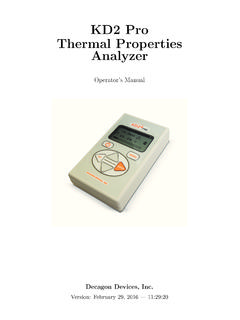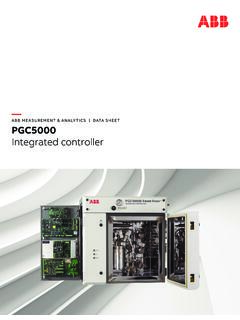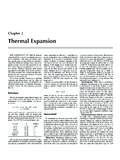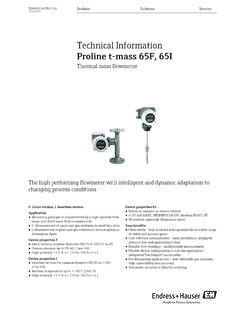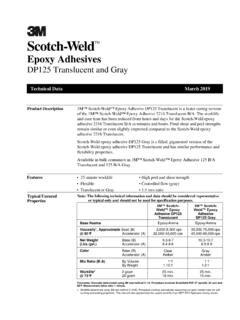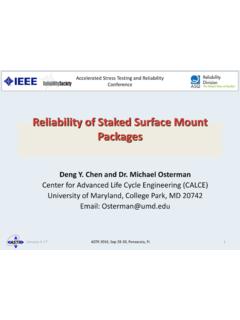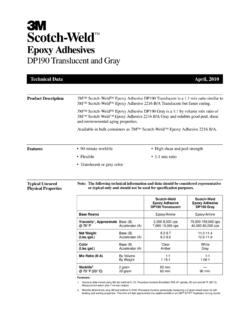Transcription of Thermal and Mechanical Properties of EPR and XLPE Cable ...
1 F E A T U R E A R T I C L E. Thermal and Mechanical Properties of EPR and XLPE Cable Compounds Key Words: EPR, TRXLPE, Thermal conductivity/resistivity, Thermal diffusivity, heat capacity, Thermal expansion, Thermal decomposition Introduction Xiaoguang Qi and Steven Boggs T hermal and Mechanical Properties of four ethylene propyliene rubber (EPR) Cable dielectrics and a tree-retar- dant, cross-linked polyethylene (TRXLPE) Cable dielectric have Electrical Insulation Research Center, University of Connecticut been measured from room temperature to 140 C. The measure- ments were carried out by the Institute of Materials Science, University of Connecticut on samples prepared by Cable manu- facturers. Dynamic Mechanical analyzer (DMA), thermogravimetric analyzer (TGA), differential scanning calo- The Mechanical and Thermal rimeter (DSC), and thermomechanical analyzer (TMA) data were measured by professional staff of the Institute, and Thermal con- Properties of EPR Cable dielectrics ductivities were measured by the Electrical Insulation Research are very stable with temperature.
2 Center. In the areas addressed by this contribution, the data up- date and expand on previous work [1]. The EPR samples took the form of plaques and cylinders, which were prepared by the companies that supplied the com- pounds, all of which are in commercial production. The commer- cially available TRXLPE samples were obtained from a com- pany that had stock and made the samples for measurement. The (1). labeling of compounds is consistent throughout the paper, , EPR1 for Thermal conductivity measurements is the same com- pound as EPR1 for the TGA, DSC, etc. where q is the power per unit length (W/m), k is the Thermal conductivity (W/m-K), r is the distance from the line heat source, Thermal Data Ei is the error function, and is the Thermal diffusivity (m2/s), Underground transmission of electric power is limited by the which is the ratio of the Thermal conductivity (W/m-K) to the ability to dissipate heat from the conductor through the insula- volumetric heat capacity (J/m3-K).
3 This can be expanded in the tion of the Cable and into the surrounding soil. Table 1 shows the form: Thermal conductivity (or resistivity) for a range of materials. A. Thermal Conductivity Measurement (2). If a line heat source which dissipates constant power is placed in an infinite solid, the temperature of the line heat source versus time is given by: where D is Euler's constant. All but the first term go to zero at long times, so that at long times: May/June 2006 Vol. 22, No. 3 19. Table 1. Thermal Proper ties for a Rang e of Materials Thermal Thermal Material conductivity resistivity (W/m-K) ( C-cm/W). Cu 390 Al 240 BeO Ceramic 30 ZnO element 15 Good Soil 1 to 2 50 to 100. Polymers to 300 to 1000. Aerogel 5000. Figure 2. Typical measured data. The temperature becomes a linear function of ln(time) after about 60 s.
4 (3). reproducibility of the data is indicated by duplicate measure- ments at a number of temperatures. The precision of the data Thus if we plot temperature versus ln(Time), we can deter- appears to be better than 3%. mine the Thermal conductivity, k, if we know the power dissipa- The Thermal Properties of the EPR compounds are very stable tion per unit length, q. Figure 1 shows a plot of the relevant from 20 C to 140 C with only a slight decrease in the Thermal equations. Figure 2 shows a plot of temperature versus ln(Time) conductivity as a function of temperature. The Thermal proper- for data typical of the present study. Figure 3 shows a linear ties of the TRXLPE are similar to the majority of EPR com- regression to such data from 60 s to 300 s, from the slope of pounds up to about 80 C.
5 Between 80 C and 120 C, the Thermal which the Thermal conductivity is determined as above. Properties of the TRXLPE are affected by melting of the crystal- lites over this temperature range. Above about 120 C, the TRXLPE. B. Thermal Conductivity Data is essentially amorphous and has a lower Thermal conductivity Figure 4 shows the measured values of Thermal conductivity than the EPR compounds. The EPR compound with a higher from 20 C to 140 C for the four types of EPR Cable dielectric Thermal conductivity has a greater filler concentration than the and TRXLPE, and Figure 5 shows the Thermal resistivity. The other compounds, as will be seen from the TGA data discussed below. Figure 1. Plot of the equations relevant to measurement of Figure 3. Typical linear regression to measured data from Thermal conductivity.
6 Which the Thermal conductivity is determined. 20 IEEE Electrical Insulation Magazine the Thermal conductivity. The materials that fall well off the line of proportionality tend to be porous, such as cork, polymer foams, etc. Figure 6 shows such a plot [2]. The exception to such proportionality would be when a mate- rial is going through a phase transition, at which point the volu- metric heat capacity increases greatly, resulting in a large reduc- tion in the Thermal diffusivity. The increase in heat capacity means that the material must absorb more heat at one location before the heat can diffuse through that location, which results in a reduction in the rate of diffusion. The time required for heat to diffuse a distance, x in a material with a Thermal diffusivity . is given by x(t) = at.
7 The Thermal diffusivity of polymers is about 10-7 m2/s [( W/m-K)/(2x106 J/m3-K)]. Thus in 1 s, heat will diffuse about mm. The time for heat to diffuse across the ~5 mm of a 15 kV Cable dielectric is about 3 minutes. Heat capacity typically is measured with a differential scan- ning calorimeter (DSC) that has been calibrated using indium. Figure 4. Thermal conductivity as a function of temperature The basic principle of a DSC is shown in Figure 7. The instru- from 20 C to 140 C for four EPR Cable dielectrics and ment has two pans , and the materials in the two pans are heated TRXLPE. The reproducibility of the data is indicated by at a constant rate while the heat energy required to achieve this is duplicate measurements at a number of temperatures. measured. If one pan is empty and the other contains the sample of interest, the difference in the heat required to heat the two samples is that required to heat the sample of interest.
8 Figure 8. shows typical data that result. Crystallization is exothermic; that C. Thermal Diffusivity and Heat Capacity is, it gives off heat; melting is endothermic, , requires that heat be added. Under steady-state conditions, only the Thermal conductivity Figure 9 shows the heat capacity of the four EPR compounds is relevant. Under transient conditions, the Thermal diffusivity and TRXLPE as a function of temperature. Because the EPR. becomes relevant. The Thermal diffusivity is the ratio of the ther- polymer has very little crystallinity, almost no melting peaks are mal conductivity (W/m-K) to the volumetric heat capacity (J/m3- visible for the EPR compounds. The TRXLPE has substantial K). The volumetric heat capacity of all solids is about the same, crystallinity, which results in a large melting peak between 50 C.
9 In the range of 2 MJ/m3-K to 3 MJ/m3-K. Thus if we plot Thermal and 120 C with most of the melting taking place between 80 C. conductivity versus Thermal diffusivity, we tend to get a straight and 120 C. As the amorphous polymer has a greater volume than line, because the Thermal diffusivity tends to be proportional to the crystalline polymer, this melting is accompanied by a very large Thermal expansion, which is of greater practical signifi- cance than the effect on Thermal Properties . Mechanical Properties A. Thermal Expansion Measurement of the Thermal expansion of TRXLPE is diffi- cult because above the melting point of the crystallites, the yield stress becomes very small and the force of the probe on the sample is likely to distort the sample. Figure 10 shows the Thermal ex- pansion coefficient of the four EPR compounds and TRXLPE.
10 From 20 C to 140 C. The expansion coefficient of the EPR Cable dielectrics is given in the legend. As noted above, melting of the crystallites in TRXLPE results in a very large Thermal expansion of the Cable dielectric. A large interfacial pressure is required for the dielectric integrity of many Cable accessories, and the con- cern is that the large Thermal expansion of TRXLPE combined with the low yield stress above the melting point (discussed below) will result in permanent deformation of the cross-linked Figure 5. Thermal resistivity as a function of temperature for polyethylene (XLPE) which lowers the interfacial pressure upon four EPR Cable dielectrics and TR-XLPE. The data are the cooling. The EPR Cable dielectrics do not suffer from such ther- same as plotted in Figure 4, but represented as Thermal mal expansion and maintain a more stable yield stress as will resistivity rather than Thermal conductivity.
